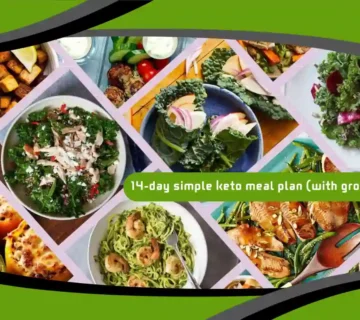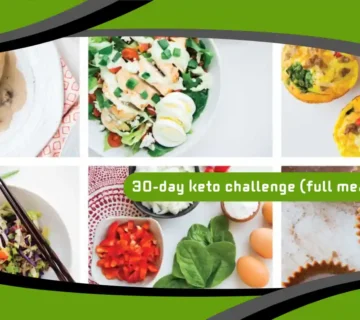Ramadan is a sacred time for spiritual reflection, discipline, and physical detoxification. But combining intermittent fasting with the ketogenic diet during this month can feel challenging without proper planning. The fasting window (from dawn to sunset) limits food intake, and traditional Ramadan dishes tend to be rich in carbs and sugars. However, with the right knowledge and meal choices, a keto lifestyle can seamlessly align with the Ramadan schedule. This guide presents practical, nutrient-dense, and delicious keto-friendly ideas for Suhoor and Iftar, keeping you energized, focused, and in ketosis all month long.

Understanding the Intersection: Keto & Ramadan Fasting
The ketogenic diet and Ramadan fasting actually complement one another when approached wisely. On keto, your body shifts from burning glucose to utilizing ketones, which are derived from fat. This metabolic state enhances mental clarity, stabilizes blood sugar, and reduces hunger—making it ideal for long hours without food. However, the reduced eating window during Ramadan means you need strategic nutrient intake, hydration, and proper electrolytes. The goal is to avoid carb-heavy traditions and instead embrace whole, fat-rich foods that nourish the body and sustain energy throughout the fast.
Key Nutritional Priorities During Ramadan on Keto
Maintaining keto during Ramadan requires a focus on three key pillars: fat, hydration, and electrolytes. Start your Suhoor with slow-digesting, high-fat meals like avocado, eggs, chia seeds, or coconut-based smoothies. These provide satiety and help delay hunger during the day. Electrolytes such as magnesium, sodium, and potassium are vital to avoid fatigue and brain fog—so include salt, leafy greens, and nuts. Water intake must be a priority between Iftar and Suhoor, as dehydration is common during fasting. Stick to whole-food, anti-inflammatory choices that support both fasting and ketosis naturally.
Watch also: Summer Keto Meal Plan: Light, Fresh & Easy Low-Carb Recipes for Hot Days
Suhoor Ideas: Energizing and Sustaining Until Iftar
Suhoor, the pre-dawn meal, is your fuel for the fasting day ahead. On a keto plan, it should be high in fats and moderate in protein, with minimal carbs. A great option is a chia pudding made with unsweetened almond milk, MCT oil, and topped with a few walnuts or seeds. Scrambled eggs with avocado and spinach cooked in olive oil offer both satiety and essential nutrients. A smoothie made with coconut milk, a scoop of low-carb protein powder, almond butter, and flax seeds can also work wonders. Avoid sweeteners or anything that may spike insulin early in the day.
Iftar Ideas: Breaking Your Fast the Keto Way
After many hours of fasting, the first few bites at Iftar can significantly impact your body. Break your fast with water, salt (to restore electrolytes), and a few olives or a date if you follow traditional customs in moderation. Then move on to a light bone broth or soup rich in minerals and fat. For the main meal, opt for grilled or baked proteins such as lamb, chicken, or salmon paired with sautéed vegetables or a fresh salad dressed with olive oil. Cauliflower rice pilaf, zucchini lasagna, or keto-friendly stuffed peppers can bring variety while staying within your carb limit.
Hydration & Electrolyte Tips Between Iftar and Suhoor
Fasting for up to 16 hours (or more) without water means hydration must be taken seriously during non-fasting hours. From Iftar to Suhoor, aim to drink at least 2.5 to 3 liters of water, and balance this with electrolyte-rich foods. Add pink Himalayan salt to your meals, enjoy potassium-rich avocados, and include magnesium sources like pumpkin seeds or dark leafy greens. A homemade electrolyte drink made with water, lemon juice, a pinch of salt, and apple cider vinegar can support rehydration. Minimize caffeine, which may increase fluid loss, and avoid sugary drinks, which break ketosis and spike insulin.
Keto-Friendly Ramadan Desserts (Yes, They Exist!)
Ramadan and desserts go hand-in-hand, but most traditional sweets are loaded with sugar and refined flour. Thankfully, you can still indulge while staying in ketosis. Try coconut milk panna cotta with stevia and rose water, or a simple almond flour and cocoa fat bomb. Keto konafa made with shredded coconut and cream cheese is a creative, low-carb twist on a classic. For a cooling treat, mix full-fat Greek yogurt with vanilla extract, cinnamon, and crushed walnuts. Use sweeteners like erythritol, monk fruit, or stevia, and watch your portion sizes to avoid knocking yourself out of ketosis.
Watch also: Flavor-Packed Keto Buffalo Chicken Wings – Quick & Clean Recipe
Meal Planning Strategies for a Successful Keto Ramadan
With limited time to eat and prep during Ramadan, planning is everything. Batch cook proteins like grilled chicken, kebabs, or lamb stew in advance and store in airtight containers. Pre-cut vegetables and prepare salad bases for easy Iftar assembly. Use meal planning apps or simple charts to map out your week and avoid last-minute carb temptations. Try to cook once daily after Maghrib and repurpose leftovers for Suhoor or the next day. Keeping your kitchen stocked with keto staples like eggs, coconut oil, nut butters, herbs, and non-starchy vegetables will make the process smooth and stress-free.
Supplements to Support Keto & Fasting During Ramadan
To stay nourished and avoid keto fatigue during Ramadan, consider incorporating supportive supplements. Electrolyte powders without sugar are helpful if you’re feeling lightheaded or weak. Magnesium glycinate or citrate can improve sleep and ease muscle tension. Omega-3 fatty acids support brain function and inflammation control—ideal during fasting. Vitamin D is also worth monitoring, especially if your sunlight exposure drops. MCT oil or exogenous ketones may give an energy boost, but use them wisely and not as a crutch for poor dietary habits. Always consult a professional before starting new supplements.
Conclusion: A Mindful, Nourishing Ramadan with Keto
Ramadan is a time to purify both body and soul—and the ketogenic diet can enhance this journey when done thoughtfully. By prioritizing healthy fats, hydration, and clean ingredients, you’ll not only stay in ketosis but also support your fasting goals with greater energy, focus, and spiritual clarity. With balanced Suhoor and Iftar meals, careful planning, and nourishing habits, your Ramadan can be both deeply fulfilling and metabolically supportive. Embrace this sacred month with intention, grace, and a table full of delicious, keto-friendly options that align with your faith and your health.
Watch also: Keto Deviled Eggs with Bacon Recipe – High Protein & Zero Guilt



No comment